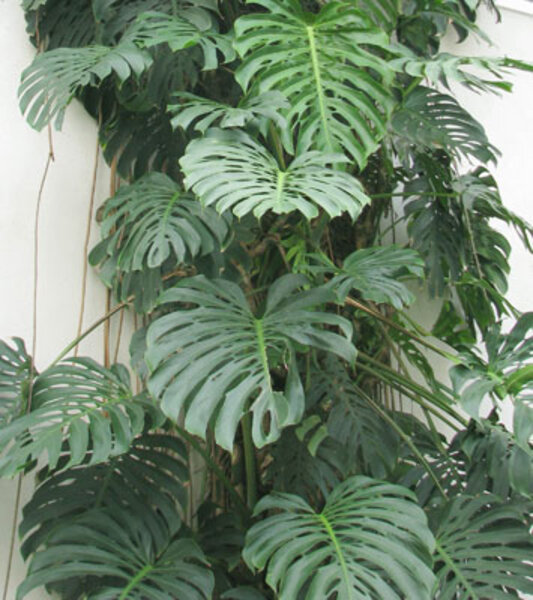A misnamed houseplant that's good enough eat
Ask for the real philodendron to stand up, and you might be surprised at one plant that does not rise: the split-leaf philodendron, sometimes called the Swiss cheese plant.
Split-leaf philodendron is a philodendron look-alike, with smooth, glossy leaves and brown roots dangling from the stems like thick cords. Like a real philodendron, it also has a hardy disposition, tolerating low light, dry air, and neglectful watering as well as any other good houseplant.
Pretty much the only response a split-leaf philodendron will have to abuse will be new leaves that are undersized and lack the deep cuts and holes that under ideal conditions give them the name Swiss cheese plant. Full leaves make split-leaf philodendrons look even more like most real philodendrons.
But make no mistake: split-leaf philodendron is not a philodendron at all. Its botanical name, rather than Philodendron, is Monstera — not in a frightening sense but in the sense that the leaves can grow very large, even 2 or 3 feet across.
Monstera, although different from philodendron, is admittedly a close relative, sharing the same family as philodendron, along with Jack-in-the-pulpit and calla lily.
What unites these plants in a common family is their unique flowers. Individual flowers are themselves ho-hum; they are striking in the way they are packed tightly along an upright, fleshy spike, the whole spike rising just above one or two broad, brightly colored bracts.
A bract is a modified leaf at the base of a flower, and is often more showy than the flower itself — the red bracts of poinsettias are another example.
You've probably come upon Jack-in-the-pulpit or calla lily flowers in the woods, a garden or a florist's shop, but you may not have come upon flowers of a split-leaf philodendron.
That's because split-leaf philodendron's flowers develop only under nearly ideal growing conditions, which for this plant means high heat, high humidity, and high light.
These are conditions found in either the tropics or a warm greenhouse. There, a young plant might flower as soon as two years after it has been propagated as an incidentally very easy-to-root stem cutting. The 10-inch spike surrounded by a boat-shaped white bract is spectacular.
Fruits that follow such flowers make split-leaf philodendron even more interesting, and give rise to the second part of its botanical name: deliciosa.
This fruit is occasionally seen in markets, especially those specializing in tropical delicacies, sometimes under the name ceriman. As the fruit develops, the spike begins to look like a long pine cone covered with small, hexagonal plates of green rind covering individual edible kernels.
Caution: You wouldn't want to taste the fruit before it is ripe, because the high oxalic acid concentration at this stage can cause a burning sensation in your throat.
The fruit signals its ripening by turning a lighter color, almost yellow, and by shedding bits of its rind. All the kernels do not ripen at once, but the fruit can be clipped from the plant when ripening begins, then wrapped in plastic and held at room temperature to finish ripening completely without falling apart.
Bite into the individual, pale, juicy kernels, and what you would taste would be a combination of pineapple and banana, with a slight hint of apple.
-----
Follow us on Twitter and Facebook.
To read more about gardening, see the Monitor's main gardening page and our lively gardening blog, Diggin' It. Both of these have new URLs, so we hope you'll bookmark them and return. Want to be notified when there's something new in our gardening section? Sign up for our RSS feed.





